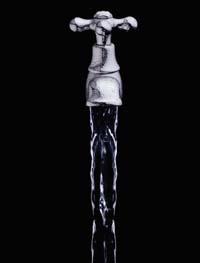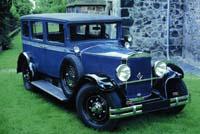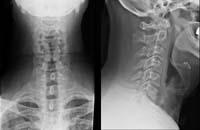As heavy as lead

Although for many the theory is incredible, it must be taken into account that the diet not only affects the health of people, but also the health of societies and even the development of civilizations.
For example, quinoa was a sacred seed for the Incas, which seems to be the one that made the most powerful empire in South America become a time when quinoa has more protein than corn or potato that they ate in other countries, which made them stronger than the rest.
Apparently, the opposite occurred in Rome. Lead abuse and many intoxications. In fact, the doctors of the time knew that lead was poisonous. More than 2,000 years ago, a Greek poet named Nikander wrote about the evil caused by lead. This disease was later called saturnism, since they joined the lead with the god Saturn. In fact, for the Romans lead was the father of all metals, and Saturn, who ate his son, was the first of all gods.

It is no wonder that lead is considered the father of metals. It was a cheap, affordable and very useful metal. They used it for everything. It was a component of makeup and masks, pigment of many paints, an effective spermicide, a basic metal of coins and household utensils, a delight of food and beverages, and the raw material of urban water pipes.
Apparently, they did not believe that the use of lead was so harmful. In the rest of the cases, undoubtedly. For example, it was customary for miners to suffer from acute intoxication. For this reason, the Romans used slaves for this work.
For the extraction of lead from the mineral was melted and in this operation toxic gases were produced. However, the superior Romans did little care to intoxicate forging staff. They did not run the risk of suffering an acute intoxication, since they did not do that work.
Lead, wine and drop

According to the writings, wine seems to be the main cause of intoxication. For the production of the wine, it was cooked in lead containers, and then a compound called lead sugar was formed. In fact, this compound is lead acetate, an effective substance against fungi.
Jerome Nridugu, a scientist at the University of Michigan, has studied the influence of lead poisoning on the decline of the Roman Empire, and estimates that 60% of the lead taken by the upper Romans came from wine. According to the amount of wine they took, the rich took 250 mg of lead a day. On the contrary, the normal and slave population consumed between 30-15 mg daily.
The World Health Organization (WHO) limits to 40 mg/day, which poses a risk of chronic intoxication. Therefore, if Nriago's calculations are correct, it is clear that the rich had a great opportunity to poison themselves. And, as explained in the chronicles of the time, they were seen, since they presented clear symptoms of lead intoxication: not only gout, but sterility, loss of intelligence, melancholy...
Therefore, although to avoid poisoning wine was consumed in golden vessels, there is no doubt that they consumed too much lead. However, it is not known to what extent it influenced the decline of the Empire, but many experts believe it was one of the factors to a greater or lesser extent.

Rear fuel: Rear fuel
However, despite knowing that lead is toxic, it has been widely used after the fall of the Roman Empire. In addition to their previous applications, they looked for new ones. In the Middle Ages, for example, alchemists tried to convert cheap metals into gold, and in their experiments lead was a basic component. But more important was the use made by Guttenberg, since the letters of the printing press were of lead.
Other uses were not so noble. For example, the Renaissance aristocrats used to poison their enemies. Although he did not kill immediately, it was difficult to perceive and very effective. Later it was used to make firearms and ammunition.
And they were used for more things. Thus, XX. In the eighteenth century it was very widespread. In 1980, for example, the world consumed 3.25 million tons, of which 40% were consumed in one country: USA. This means that each American used 5,221 grams of lead a year, 10 times more than the citizens of the Roman Empire! However, the rich Romans took the lead through wine, while the Americans and, in general, the inhabitants of the industrialized countries assimilated the lead they mixed to fuel.

Well, it is very important when the gasoline begins to burn. Gasoline engines include gasoline vapor and air in the engine cylinder. There it compresses the pistons and then a spark occurs in the spark plug and the mixture is burned. However, depending on the hydrocarbons present in the fuel, it may occur that it begins to burn without the need for spark by simple compression. However, the fact of burning only harms the engine and reduces its efficiency. This happened with the gasolines with little octane.
However, in 1921 a chemist who worked for General Motors (Thomas Midgley) showed that lead tetraethylene was very good to raise octane. That is, if we add this compound to the gasoline it did not begin to burn until the spark was lit and the combustion was slow and effective. For this reason, from then on all the gasoline carried the tetraethylene lead.
They soon saw that lead added to gasoline was dangerous. Midgley himself was intoxicated and sick and several operators who made tetraethylene lead died with the lost head. In May 1925, the U.S. Department of Public Health. It banned the production and sale of lead gasoline and launched a study to analyze the relationship between gasoline and lead and those deaths. But only within seven months to check if there was any relationship and they did not get the final test. Without testing and with the pressure of the industry, the gasoline with lead was expanded all over the world.
However, the suspicion that it was harmful to health was not eliminated. Certain control measures were established that were progressively decreasing the amount of lead that could be used in gasoline. Finally, in 1995 it was banned the sale of gasoline with lead in the US and in 2000 in the European Union.

Lead everywhere
The prohibitions have affected. The analysis in the atmosphere, in the water, and especially in the soil, show the direct relationship between the amount of lead added to gasoline and the quantity found in the environment, and as the measures are adopted, the amount of lead detected in the environment has been decreasing. However, this has occurred especially in developed countries, where lead gas is still used in other countries.
On the other hand, gasoline is not the origin of all the lead present in the environment, since it has many uses. Some of them are disappearing just like it happened with gasoline because they have shown their dangerousness. For example, a lot was used for the manufacture of pigments or water pipes, but it is now forbidden in many places, because for them it is easy to pass people and the environment. However, they still have a lot of lead, such as ceramics, brass and vinyl made in China (for electric cable covers).
At present it is mainly used in acid lead batteries of cars. In fact, 88% of lead consumed in the US. is used in automotive batteries and industry. And although gasoline with lead is prohibited in cars, the fuel of the planes carries lead. It is also used for the manufacture of ammunition and candles, the collection of high voltage cables and the addition to fast reactor coolants, among others. You can't deny its usefulness, but as is dangerous, most applications are looking for alternatives.

The forecasts made by the US Department of Geology. In 2005 they anticipated to increase the use of refined lead in the next two years. In 2007, demand in the U.S. was estimated to decrease by 3% (especially in acid lead batteries) and Europe would maintain demand for previous years. In China, for its part, demand was expected to increase by 10% and a similar rise was expected in India, Mexico and Thailand. Yes, it is very difficult to replace all lead.







